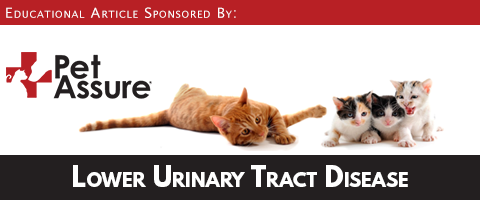Feline Lower Urinary Tract Disease (FLUTD) is an infection that leads to problems in the bladder and urethra. Left untreated, FLUTD can lead to acute renal failure, which is failure of the kidney.
FLUTD is a common disease in adult cats. Adult males are more prone to it because they have a longer and narrower urethra, and are more susceptible to blockages.
CAUSES:
The cause of FLUTD is usually unknown. Some sources of infection may include:
- Bacterial, fungal, and viral infection
- Bladder stones
- Poor diet
- Inadequate water intake
- Urinary pH
- Stress
- High mineral intake
SIGNS:
A cat with Feline Lower Urinary Tract Disease may have some or all of these signs:
- Bloody urine
- Straining or inability to urinate; vocalization during urinating attempts
- Urinating in unusual places outside of the litter box: most often on cool surfaces
- Urinary blockage: almost exclusively a male cat problem
- Licking the urinary opening: usually due to pain
- Frequent bathroom trips with little urine
As time passes, the bladder fills up with urine and causes painful bladder expansion, due to pressure. Kidney failure can follow within hours. Your cat may show the following signs as the infection progresses:
- Distressed, and may howl or cry out in pain
- Seeking seclusion
- Stopping ofeating and drinking
- Vomiting
- Lethargy
- Unconsciousness as poisons build up in the bloodstream
If you notice ANY of the above-mentioned signs, CALL YOUR VETERINARIAN IMMEDIATELY. Untreated FLUTF is usually fatal.
If you are not sure if your cat is able to urinate, assume that there is an emergency and call your veterinarian’s office right away.
DIAGNOSIS:
Your veterinarian can diagnose your cat in a number of ways:
- Check forsigns
- Physical exam: applying light pressure on the bladder and assessing your cat’s reaction
- Blood tests
TREATMENT:
Most veterinarians will recommend the following treatments for cats with lower urinary tract disease:
- Antibiotics
- Prescribed diet: wet food and increased water intake
- Surgery: for cats that are prone to recurrences
PREVENTION:
Water is the most important part of a cat’s diet and is the best preventative of FLUTD. Diets low in magnesium and urine acidifiers may be helpful.
PROGNOSIS:
For long-term management of FLUTD, make sure your cat gets plenty of water to drink.
After treatment and recovery, you should still check your cat regularly for urinary problems. Urinary tract disorders have a high rate of recurrence.



